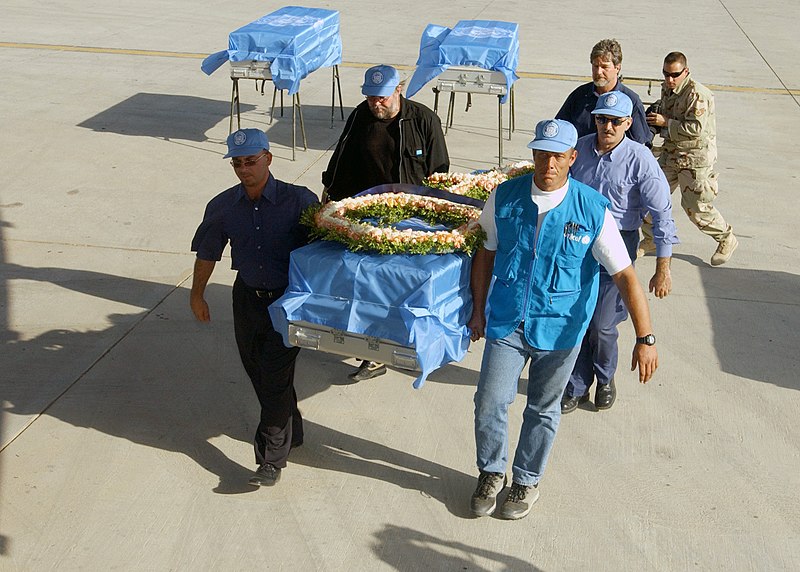
The recent article by fellow Australian Gordon Weiss on the UN and Australia’s place in it brought to mind the extreme dangers often faced by both national and international humanitarian relief workers with the UN, the Red Cross movement (the International Committee of the Red Cross and the International Federation of Red Cross and Red Crescent Societies) and non-governmental organisations.
In my own UN experience over 15 years in northern Iraq, Sudan, Somalia, Israel/Palestine and the UN Mine Action Service, I have witnessed the dangers to such workers from wars, armed conflicts, terrorism, assassinations and natural disasters. The continued absence over the past several decades or more of world war or anything approaching it has been offset by a plethora of both state and non-state actors using violence to achieve their objectives.
A worrying development over that time has been the marked increase in targeting of UN and associated humanitarian relief personnel in crisis countries and regions. In one sad instance, two UNICEF workers who inadvertently drove into an ambush between known rebel groups in what was then southern Sudan were executed by the side of the road. The incriminating orders were captured at base by the UN on two-way radio.
Staff of the International Committee of the Red Cross have suffered horrendous casualties in many theatres of conflict. Much-acclaimed Afghan deminers working in Afghanistan for national NGOs in landmine-clearance operations and supported by the UN suffer fatalities not just from the mines they locate and destroy, but also from the Taliban and other insurgent groups.
In Sudan, as the country battled through a decades-long civil war that saw the eventual creation (in 2011) of a new state of South Sudan, we as UN coordinators were haunted by the epidemic of killings, kidnappings, general mayhem and attrition rates not only within civilian communities, but also directed at UN and NGO staff there trying to help.
Extreme violence towards UN personnel has been occurring since the very beginnings of the UN in the mid-1940s, even at the most senior levels. In 1948, the secretary-general’s special envoy to newly created Israel, UN Under-Secretary-General Count Folke Bernadotte from Sweden, was assassinated on a busy Jerusalem street.
In 1961, the UN secretary general himself, Dag Hammarskjold, also of Sweden, died in a plane crash in southern Africa when he was centrally involved in trying to stop the conflict in the Congo. Rumours persist to this day of foul play in the crash itself.
In 2003, yet another UN under-secretary-general and leader of a humanitarian mission to Iraq, Sergio Vieira de Merlo, died in the rubble of the Canal Hotel in Baghdad along with 22 other UN personnel (including Rani, my Filipino office manager from an earlier time in Iraqi Kurdistan), blown up by terrorists.
The great majority of UN and associated humanitarian workers are nationals of the countries receiving humanitarian relief assistance. They bear the brunt of the endemic violence visited upon such workers, most times in the course of seeking to assist host populations suffering from one or more of a range of adverse events.
Such events typically include extreme weather and climate change, sickness and pandemics, and internal armed conflict. In the small country of Yemen in the Gulf region of the Middle East, virtually all of these factors are at play: more than half of its 25 million population are categorised by the UN as being at extreme risk. It is emblematic that the UN, together with NGOs and Red Cross organisations, are there, doing their best with limited resources to provide relief to communities under severe stress.
A smaller cohort of humanitarian relief workers are internationals from all corners of the globe, bringing to bear impartiality and neutrality in situations of violent conflict, as well as skills in the provision of relief assistance—hygiene and medicine, water and sanitation, food and agriculture.
Australians have been and are well represented in all of these key sectors, and in my own time in the UN I encountered plenty of young—and not so young—fellow countrymen and women, not only with the UN but also with the Red Cross and NGO movements. Some of them were and are never far away from the ever-present threat of external violence.
In Burundi, an Australian UN security officer pulled a concealed weapon to shoot an insurgent who had begun to murder a line-up of UN international staff and had already killed two. In Erbil in northern Iraq, a young New Zealand demining professional was assassinated on the eve of Anzac Day. In Gaza, Palestine, an Australian female officer working for UNRWA (United Nations Relief and Works Agency for Palestinian refugees) crawled into an UNRWA warehouse on fire from an air strike, to rescue much-needed food distribution vehicles from a conflagration which gutted the warehouse.
Australian ex-military veterans, many with specialist skills, are well represented and well thought of in the UN-coordinated work dealing with the scourge of landmines and unexploded ordnance. There have inevitably been many fatalities in this particularly dangerous area of humanitarian work, including of Australians.
The protection of humanitarian assistance personnel remains an ongoing and critical challenge for the UN. A web of international human rights and humanitarian law provides umbrella protection, and host governments have clear responsibilities to protect. This is not enough, and so the UN secretariat includes in its structure a department of safety and security whose role is to provide optimum protection for staff and dependents, and the safest possible conduct of humanitarian relief operations.

